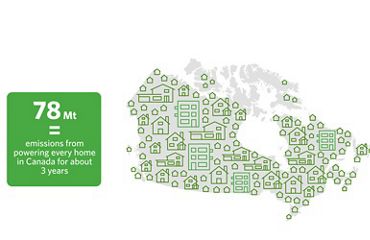
Natural Climate Solutions essential to successful Emissions Reduction Plan, green economic transition
Actions to protect, better manage and restore nature will help Canada accelerate the race to net-zero that benefits people and economies.
Media Contacts
-
Jacqueline Nunes
Director of Marketing
Email: jacqueline.nunes@natureunited.ca
Emissions Reduction Plan Released
Read our statement on the contents of the ERP released on March 29, 2022. Read our statement.
The following is a statement from Hadley Archer, Executive Director:
Canada's first-ever Emissions Reduction Plan is a historic opportunity to maximize the power of nature to reduce our country’s emissions through actions that are available now, are cost-effective and are essential for meeting our 2030 climate targets.
Peer-reviewed science shows that Natural Climate Solutions—actions to protect, better manage and restore forests, wetlands, grasslands and farmlands to avoid and sequester greenhouse gases—can reduce Canada’s annual emissions by 78 megatonnes in 2030, which is equal to 11% of our current annual emissions.
Quote: See Our Natural Climate Solutions Study

Natural Climate Solutions are ready to deploy now, providing a biological bridge to a low-carbon future in the near term.
The ERP, which is due on March 29, must accelerate NCS through sectoral strategies on agriculture, forest stewardship and the blue economy, as well as measures to support avoided grassland and peatland conversion. NCS are already a key feature in Canada’s strengthened climate plan to reduce emissions by 40-45% below 2005 levels by 2030, on the way to net-zero by 2050. The ERP must build on the federal investment of $4.1 billion in NCS announced in 2021, which is largely focused on a national tree-planting initiative that will deliver major emissions reductions in 2050.
Respect for Indigenous rights and authority is foundational for advancing NCS, alongside the knowledge, participation and consent of Indigenous peoples in the design of these solutions. Indigenous-led NCS integrate time-proven and effective approaches for land stewardship that will help advance commitments towards conservation, biodiversity, adaptation and reconciliation .


More Resources
- Latest IPCC Report calls out nature as a key solution
- 395 million new jobs by 2030 if businesses prioritize nature according to World Economic Forum
- Regenerative agriculture could reduce emissions by more than half according to research by Bain and Nature United
- Coastal First Nations estimate a 10:1 return on investment from Indigenous Watchmen program in Great Bear Rainforest
NCS are ready to deploy now, providing a biological bridge to a low-carbon future in the near term. Many solutions are available at less than $50 per tonne of CO2e.
NCS provides tools for farmers, foresters and local communities, which today stand on the frontlines of the climate and biodiversity crises and at the crossroads of a green economic transition. And as companies look to their value chains to find emissions reductions to reach net-zero, NCS can catalyze much-needed private investment in natural assets, ecosystems and practices that can help decarbonize key sectors of our economy.
The World Economic Forum estimates that Natural Climate Solutions have the potential to create $10.1 trillion USD annually in business opportunities and 395 million jobs by 2030. Research by Nature United and Bain & Company shows the potential of NCS to increase farmers’ revenues by 30%.
Quote
Natural Climate Solutions provide tools for farmers, foresters and local communities, which today stand on the frontlines of the climate and biodiversity crises and at the crossroads of a green economic transition.
The next federal Budget, anticipated to be released the following week, must affirm the ERP and send the message to rights-holders, stakeholders and markets that our federal government is serious about implementing its climate plan. While Canada and the world grapples with competing priorities, even intermitted investments in the budget would signal that the dual crises of climate and biodiversity will not be put on hold.
Canada’s first ERP will mobilize contributions from all sectors, and it will guide actions and accountabilities across government for the next four years—nearly halfway into a decisive decade for climate action. The Government of Canada must act now to maximize the power of nature to deliver deep and durable emissions reductions, for the benefit of nature and people.
Nature United was founded as a Canadian charity in 2014, building on decades of conservation in Canada. Headquartered in Toronto, our organization has field staff located across the country. Nature United supports Indigenous leadership, sustainable economic development and science and large-scale conservation, primarily in British Columbia, the Northwest Territories and Manitoba. Our organization is also working to accelerate Natural Climate Solutions at national and regional scales. To learn more, visit natureunited.ca or follow us on Linkedin, Instagram and Facebook.
We are the Canadian affiliate of The Nature Conservancy, a global conservation organization with more than a million members and a diverse team that includes more than 400 scientists. Our global organization works in more than 80 countries and territories — either directly or through partnerships — to conserve the lands and waters on which all life depends. To learn more, visit www.nature.org or follow @nature_press.